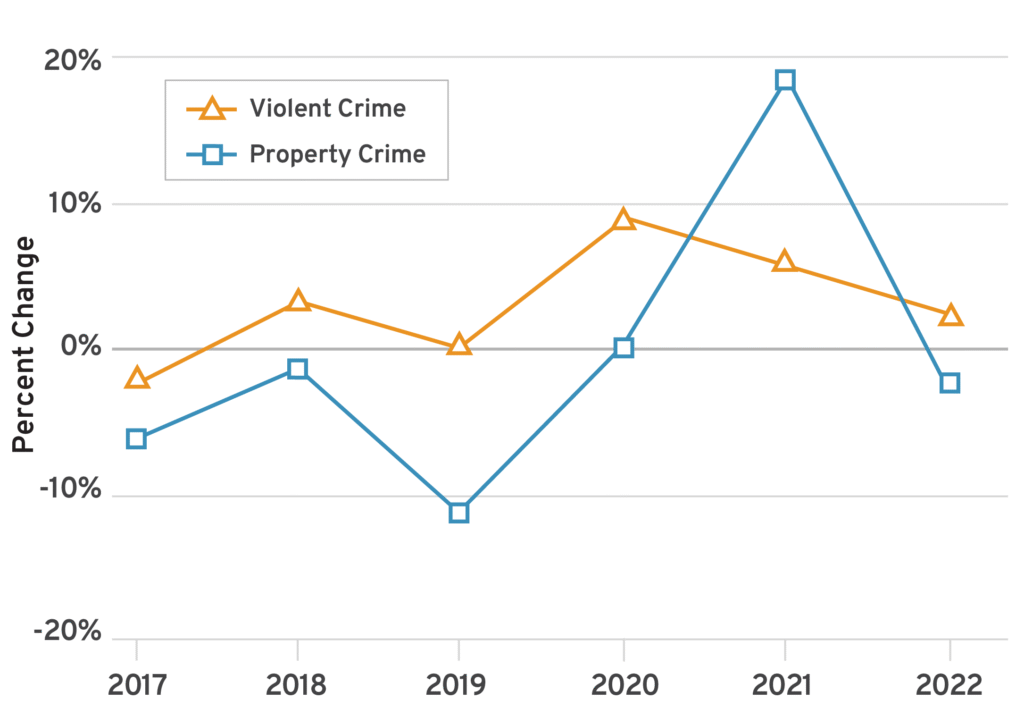Virginia’s Criminal Justice Crossroads: Opportunities for Pre-Arrest, Pretrial, and Post-Conviction Change in the Commonwealth
Oct 29, 2025
Authors
Jillian Snider
Resident Senior Fellow, Criminal Justice and Civil Liberties
Lisel Petis
Policy Director, Criminal Justice and Civil Liberties
Sarah Anderson
Associate Director, Criminal Justice and Civil Liberties
Media Contact
For general and media inquiries and to book our experts, please contact: pr@rstreet.org
Criminal Justice System Profile
Recent Crime Trends

Property crime trends (2013-2023)
Current criminal justice spending (per capita, FY 2021)
Courts: $100-$150 per capita
Corrections: $250-$350 per capita
Police: $300-$400 per capita
17.6%
Current supervision population (2023)
61,800
Violent crime clearance rates (2024)
57%
Current incarcerated population/rate
Jail and prison (2023): Total 60,000
Incarceration rate per 100,000 (2024): 679 (19th/50)
Strengths to Build On
- Virginia is one of the country’s safer states, with violent and property crime rates significantly below the national average. The “Ceasefire Virginia” initiative, launched in coordination with the attorney general and local agencies, contributed to a 30 percent drop in murders and an 11 percent reduction in violent crime statewide.
- Virginia has been a leader in pretrial justice for over two decades through its early adoption of pretrial risk assessments to bipartisan measures that eliminate some of the most harmful failure to appear responses and a robust, statewide pretrial services system.
- Virginia will soon enact its clean slate law, signed into law in 2021, allowing for automated sealing of certain criminal records for qualifying individuals.
Persistent Challenges
- Police departments are understaffed across the state, the costs of which add up in training and overtime pay, increased operational stress, and diminishing resources. Vacancy rates for departments in major areas around the commonwealth like Arlington, Richmond, Roanoke, and Norfolk are all between 20 and 30 percent.
- While codified, victims’ rights remain unenforceable, leaving them with a limited voice during the criminal proceedings of defendants alleged to have caused them harm. In fact, many localities report an inability to uphold the victims’ rights statute for all victims.
- While the commonwealth has a court notification system for defendants, it is an opt-in system that is far less effective than opt-out systems in other jurisdictions. Individuals who opt in to receive notifications are usually already more likely to appear in court, and studies report enrollment rates for opt-in programs as low as 2 percent. Virginia’s system does not currently include an easy way for victims to sign up to receive similar notifications.
- Incentives for early release from incarceration upon demonstration of rehabilitation remain limited, in terms of both resentencing opportunities and low parole grant rates. While medical and geriatric release are available, as well as parole opportunities for individuals with lengthy sentences for crimes committed as minors, Virginia approves only about 3 percent of applications annually—one of the nation’s lowest parole grant rates.
Practical Solutions
- Law Enforcement Resources. Virginia should continue its commitment to increasing recruitment and retention rates for departments by modernizing recruitment practices, committing to a culture that fosters professional growth and retention, expanding recruitment pools, and improving workplace conditions. Furthermore, to reduce officer time spent on responses to individuals better served by community behavioral health services, Virginia should commit to facilitating the ongoing implementation of the Marcus Alert program, which creates specialized response models to address mental health crises and maintain dedicated funding for them.
- Court Reminders. Virginia should implement a statewide, automated court reminder system to address the fiscal and human costs of missed court appearances. While most Virginia courts already have reminder capabilities, the current opt-in model limits their effectiveness. Automated opt-out systems significantly outperform this approach, with many states increasing court appearance rates by 20 to 40 percent. On average, each missed court date costs nearly $1,500 in wasted docket time and avoidable warrants. By contrast, automated reminders cost just $0.60 to $1 per case and have average startup costs well below 1 percent of a state’s annual judicial budget. Court reminders can serve victims’ needs as well by actively engaging them in the process (if they so choose) and making their rights clear to them at each step.
- Parole and Resentencing. Virginia should commit to a greater utilization of its parole by working to bring its parole grant rates up safely and considering the reinstatement of discretionary parole, abolished for felonies in 1995. Additionally, the commonwealth should expand opportunities for resentencing by passing second look legislation that would allow courts to revisit and potentially modify sentences of eligible individuals after they have served a significant portion of their term, somewhat similar to how the commonwealth already treats minors. These laws incentivize rehabilitation and good behavior during incarceration by offering people hope of sentence reconsideration based on their progress and making communities safer when individuals return to society.
For More Information
Check out our Criminal Justice Crossroads series on Virginia:
Virginia’s Criminal Justice Crossroads: Pre-Arrest Issues in the Commonwealth
Virginia’s Criminal Justice Crossroads: Pretrial Issues in the Commonwealth
Virginia’s Criminal Justice Crossroads: Post-Conviction Issues in the Commonwealth


